Lucien Agoumé (185cm/6’0”, 75kg/165lbs) of Serie A giants Inter Milan spent the 2021/22 season on loan in his native France with top-flight Brest, where he played 54.6% of the Ligue 1 side’s league minutes, making 27 appearances and helping his team to an 11th place league finish — their highest league finish since they achieved the same feat in the top-flight all the way back in 1990/91.
Of course, Agoumé can’t be primarily credited for that.
However, he was an important part of Michel Der Zakarian’s team and deserves some of the plaudits.
He has duly received plenty of attention for his 2021/22 performances, even earning a nomination for the prestigious 2022 Golden Boy award.
While we don’t expect Agoumé to claim the trophy, this nomination represents well-earned recognition of his impressive season on loan at Brest.
But what exactly made the 20-year-old midfielder’s 2021/22 campaign stand out?
This tactical analysis and scout report aims to provide some insight into Agoumé’s 2021/22 season, highlighting the key strengths and areas of improvement within the Sochaux academy product’s game through analysis of the player’s role within Der Zakarian’s tactics this past season.
We previously touched on Agoumé in a late-June piece for Total Football Analysis, theorising ways in which Monaco could potentially replace Real Madrid-bound Aurélien Tchouaméni.
We didn’t suggest Agoumé as a sole replacement for Tchouaméni or as a player of a similar profile, but rather discussed the possibility of pairing Agoumé with another, more attack-minded signing as a duo to rejuvenate Les Monégasques’ midfield.
This scout report aims to provide a more comprehensive look at Agoumé, looking at exactly what kind of player he is right now, as well as looking into what kind of player he has the potential to become as his promising career continues to develop.
Lastly for the intro, all stats and data used in this analysis have come from Wyscout unless otherwise stated. So, now that we’ve set the scene, let’s push on into the analysis.
Data Analysis
We’ll start this Lucien Agoumé scouting report with a little bit of data analysis.
The purpose of this section will be to provide a clear, digestible look into Agoumé’s game through data, observing some areas in which the midfielder pops out —in both good and bad ways — and determine exactly how he profiles as a midfielder.
We can take a deeper dive into specific areas of the 20-year-old’s game later on in the piece, while also touching on some bits of detail regarding Agoumé’s game in this section, discussing the data.
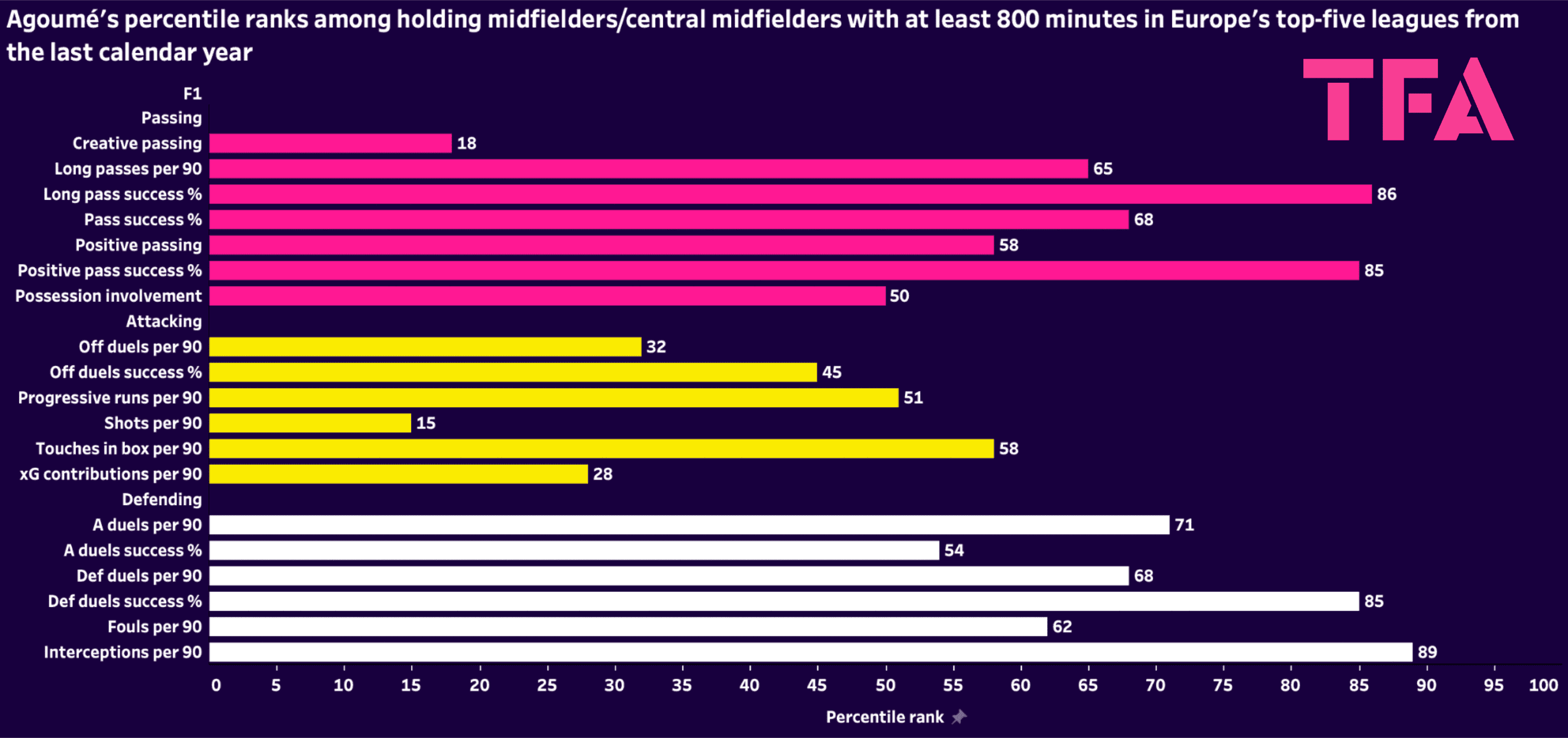
Figure 1 is a visual we’ve created to measure Agoumé against every holding midfielder/central midfielder to have played at least 800 minutes in Europe’s top-five leagues over the past calendar year in some key areas of a general midfielder’s profile.
We’ve split the data into three distinct sections, distinguished by colour and separated by the ‘passing’, ‘attacking’ and ‘defending’ labels.
Please note that the figures shown do not indicate exact values per 90 for the labelled metric — they indicate Agoumé’s percentile rank among the aforementioned set of midfielders.
So, this doesn’t say he plays 65 long passes per 90, it displays that he ranks in the top 35% of midfielders in this set for long passes per 90, for example.
We can start by discussing the ‘passing’ section, for which some metrics have been put together via Wyscout’s raw data that will be briefly explained.
‘Creative passing’ is a combination of shot assists per 90, xA per 90, key passes per 90, smart passes per 90 and through passes per 90.
This isn’t anything extremely fine-tuned that has been narrowed down, just a combination of basic metrics related to creative passing that, combined, can provide something of a view into the player’s creative passing tendencies.
‘Positive passing’, then, is a combination of forward passes per 90, passes to the final third per 90, passes to the penalty area per 90 and progressive passes per 90.
Again, there isn’t much of a science behind combining these into measurements for positive passing. The reasoning is much the same as for ‘creative passing’.
Lastly, ‘possession involvement’ is a combination of passes per 90 and passes received per 90. It indicates how involved in his team’s possession play, concerning other midfielders, Agoumé was in the last term.
While passes per 90 alone go some way to achieving this, it can be interesting to see how often his team finds him with passes too to determine his general possession involvement — especially for a holding midfielder, for whom a large part of the game is making himself available for others to target with passes as the team looms to move from the build-up phase to the ball progression phase, and then into the opposition’s final third.
Agoumé ranks quite low in creative passing — not a surprise given he was typically deployed as a deeper-lying midfielder last term and the combination used for that metric would favour a more advanced midfielder.
However, that wasn’t solely the case here either, as while pure attacking midfielders Kevin De Bruyne and Sergio Canales did fall into places one and two for the metric from those within our set, they were interestingly followed by Joshua Kimmich and Ander Herrera, who typically play slightly deeper.
From being familiar with Agoumé’s typical game, though, this doesn’t come as a shock.
The midfielder ranks quite average for possession involvement, long passes per 90 and positive passes per 90, which is partly a result of the fact he wasn’t playing for a very possession-based team in Brest, last term.
Les Pirates ended the season having played the third-fewest passes per 90 in Ligue 1 (349.25 per 90).
However, Agoumé played more passes per 90 than any other Brest player last term, which could indicate a propensity to be more active and involved in possession phases.
It’d be interesting to see the 20-year-old operating in a more possession-based team, as this may allow him to show off this area of his game more. He is comfortable enough on the ball, as will be discussed in greater detail later on.
While general possession involvement isn’t too high for Agoumé — and the pass success rate isn’t anything to write home about — his level of success with positive passing and long passing highlight an impressive area of his game, which is his quality on the ball and ability to pull off difficult actions in possession.
As we mentioned in our replacing Tchouaméni article, Agoumé can improve mentally; he can become more confident and brave with the ball; he can take risks more often.
The Internazionale man can be a great ball progressor from the holding midfield position, but he needs encouragement, development on the training ground, along with perhaps more self-confidence to become this player. Technically, he has the ability.
In the ‘attacking’ section, we’ve just used one created metric, which is fairly self-explanatory — xG contributions per 90. This is a combination of xG per 90 and xA per 90.
As you’d expect from watching Agoumé, this section is the least impressive of the three categories we’ve created in this visual. However, it’s also clear he hasn’t just been someone who sits in front of the backline and never ventures into the final third.
Agoumé spent about half the season playing as a holding midfielder, with the other half of the season spent playing as an ‘8’, typically on the left side but sometimes on the right. So, he played a relatively wide range of roles during his loan spell at Stade Francis-Le Blé in the last term.
While we see Agoumé ending up as a holding midfielder, possibly a sole holding midfielder in a 4-3-3 but also potentially in a double-pivot, he proved himself capable of operating in Ligue 1 as an ‘8’ last season.
Regardless of which specific role we judge Agoumé in, he has a lot of development to do before he’s the finished product — he’s clearly very raw with a lot of potential but a long way to go before he’s ready to run a top side’s midfield in any role.
It’s normal for young players to display versatility as they are often tasked with performing different roles while acclimatising to first-team football, and this was the case for Agoumé last season.
This explains why he made a relatively average number of touches inside the opposition’s box and progressive runs, respectively, for a holding midfielder or central midfielder in the 2021/22 campaign.
However, we can also see he wasn’t one to take opposition defenders on in 1v1 duels very often, nor did he pose much of a goal threat.
Lastly, the ‘defending’ section here is perhaps the most impressive of our three sections for evaluating Agoumé as a midfielder.
He engages in plenty of defensive duels and aerial duels, while he makes a truckload of interceptions, with the latter metric there providing his highest percentile rank of all metrics evaluated on this chart.
Agoumé’s defensive duel success rate is also stellar, while he wins a decent-if-not-underwhelming amount of his aerial duels.
This backs up the claim made that Agoumé is a very solid defensive midfielder. Like every area of his game, some fine-tuning is possible and necessary.
He’s still very raw, there’s no doubting that.
However, the 20-year-old performed excellently as a midfielder on the defensive side of things in Ligue 1 last term, putting himself in a very respectable position among Europe’s finest midfielders for defensive duel success and interceptions.
With his already-great defensive quality on display, along with the fact that he shows promise as a midfielder who can develop into something far more impressive on the ball, Agoumé profiles as someone who could develop into a very good holding midfielder in Europe’s top-five leagues.
The possibility he could develop into an ‘8’ should not be discounted but his future looks likely to lie slightly deeper, as also explained in our replacing Tchouaméni piece.
So, let’s dive deeper into Agoumé’s game to determine how he plays and what his key strengths and weaknesses are.
In Possession
The next chapter of this analysis looks at Agoumé’s qualities and performances in possession of the ball.
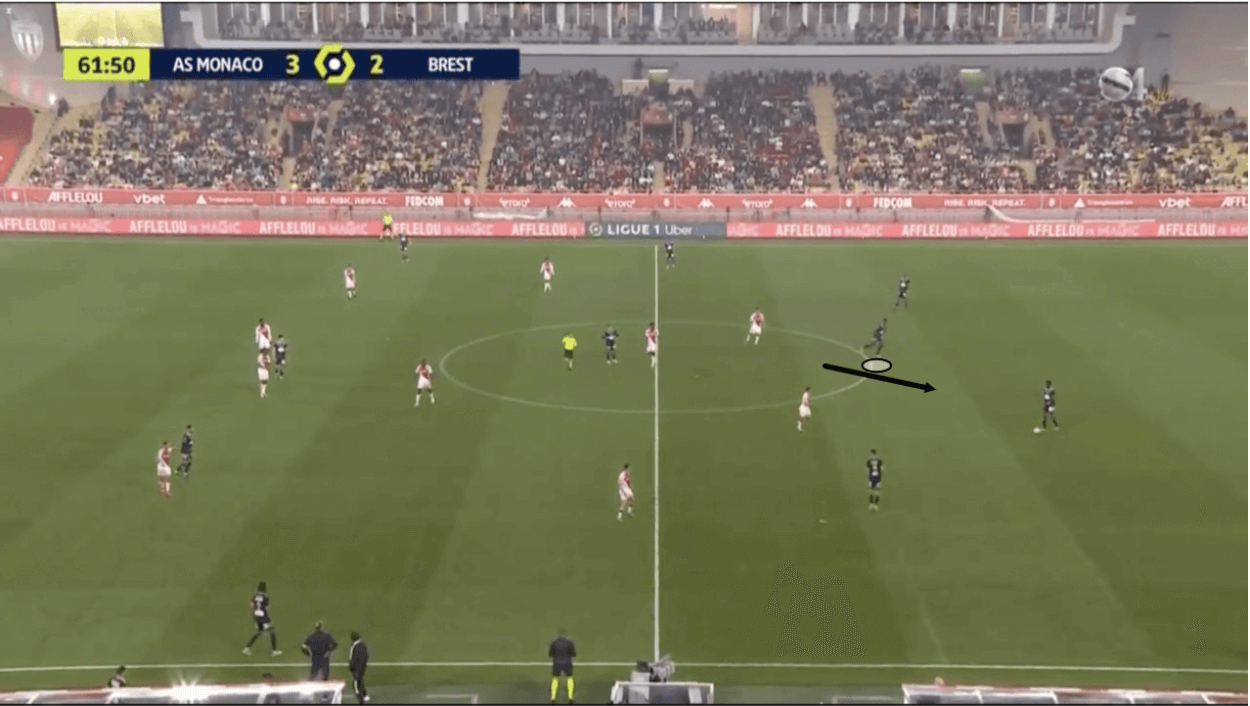
Agoumé is comfortable playing as the deepest midfielder when his team is in the build-up/ball progression phase, we see an example of the midfielder dropping from midfield to split the centre-backs as his team aims to break into the opposition’s half in figure 2, taken from late last season.
The 20-year-old intelligently spotted the necessity to drop between the two Brest centre-backs to create a numerical advantage for his side versus the opposition’s two-man line of defence up front; a plus-one advantage in the first line of attack is a fundamental aspect of many teams’ tactics, and it’s often put on the team’s deepest midfielder to create that advantage in situations like we see Agoumé in above.
So, this is an important bit of tactical intelligence for the holding midfielder to show.
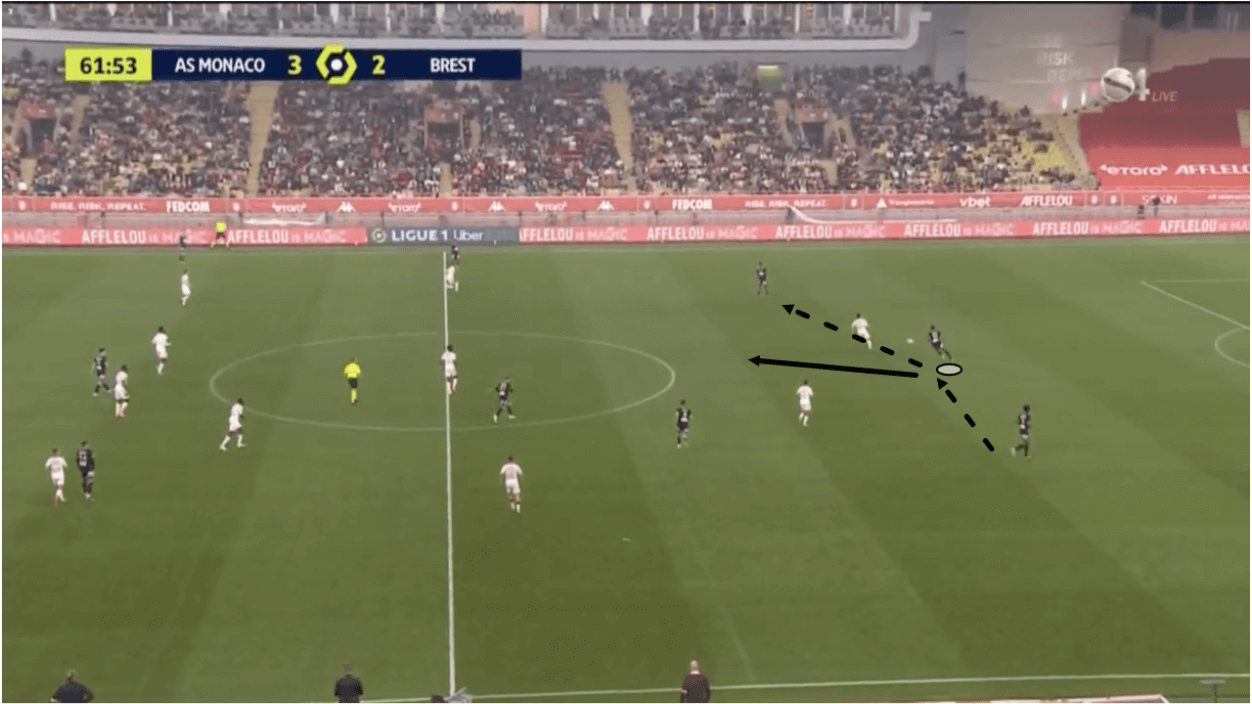
After dropping between the centre-backs, he allows them to split wider, forming better angles to play around the opposition’s two forwards and progress into midfield.
Agoumé is actually used on the ball in this instance, as the left centre-back passes the ball to him centrally.
As we can see from figure 3, this attracted the left opposition striker’s press, creating extra space for Brest’s right centre-back.
Agoumé deals with the pressure very well, casually receiving the ball, turning to face the right centre-back and sending the ball out to him.
From here, Agoumé doesn’t just stop and say, ‘job done’. After releasing the ball, he continues his involvement in the attack by running forward to try and provide the right centre-back with another forward passing option, as the solid arrow indicates on figure 3.
This passage of play exhibits excellent spatial awareness from Agoumé, as the midfielder managed to get between the centre-backs to create the first line overload for his side really well initially, as well as receive the ball, turn and play it out to his teammate on the right while under pressure without any hassle.
Additionally, the midfielder exhibited great spatial awareness along with a good attitude in figure 3, when he pushed forward off the ball to try and get involved in the game again by providing his right centre-back with a passing option in midfield beyond the opposition’s first line of pressure.
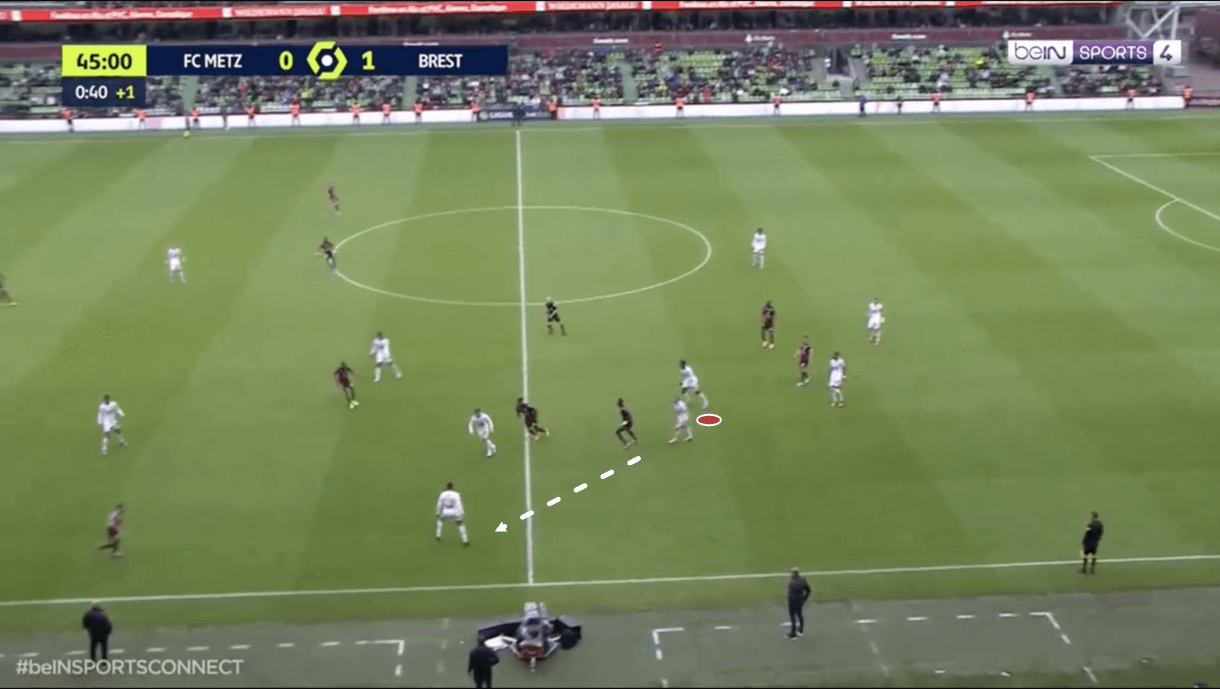
Escaping pressure like this is something we’ve seen Agoumé do quite well over the past season.
Indeed, there were times when the midfielder failed to escape pressure well enough, and thus failed to give his teammate a viable passing option and hurting the ball progression as a result.
However, in general, escaping pressure and making himself available for the team to find in the key area of central midfield can be classed as a strength in Agoumé’s game that will only become more pronounced over time as he inevitably gets the opportunity to play in more possession-based systems at club level more frequently.
We see an example of Agoumé escaping pressure again in figures 4-5.
Firstly, figure 4 shows Brest’s left-sided width-provider receiving the ball, attracting the opposition’s attention and pressure. Agoumé, circled in figure 4, sees an opportunity to use the opposition’s attention moving to the wing to make a blindside run into space centrally, providing his teammate with a viable passing option in a great position.
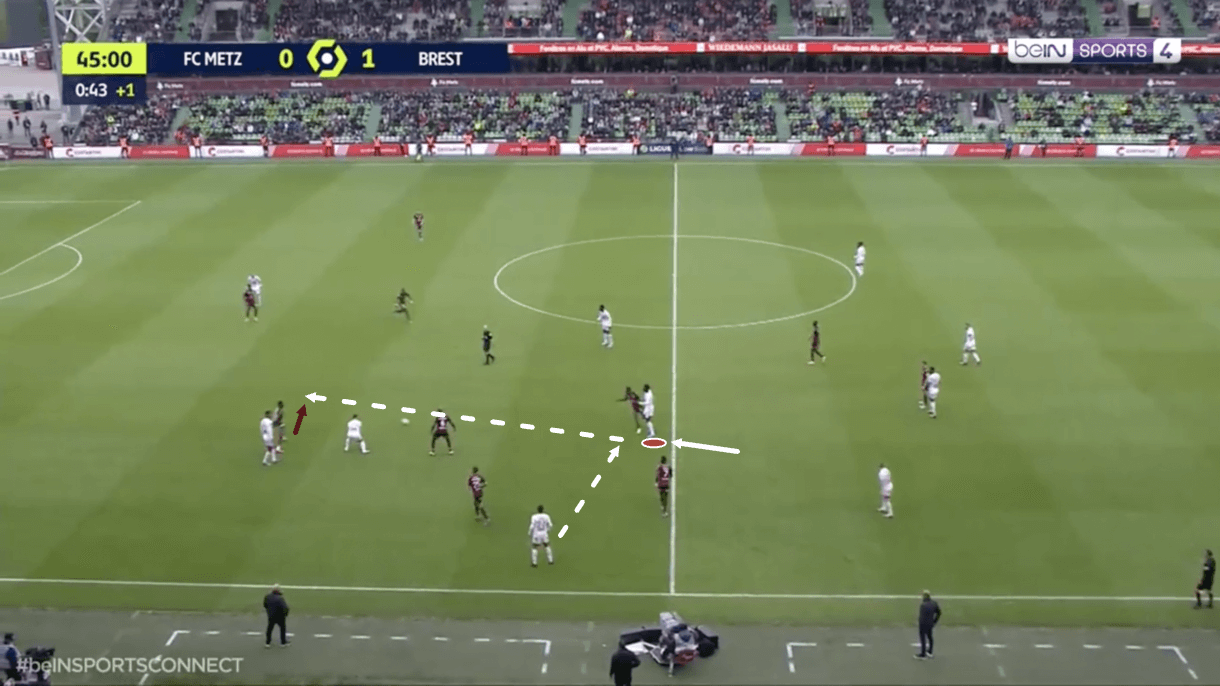
This works really well, and Agoumé ends up escaping the opposition man’s cover shadow, opening up the passing lane between himself and the left-sided ball carrier.
The ball carrier takes the option Agoumé gives him by passing into the midfielder’s running path with a well-timed and well-weighted pass.
As the play moves on into figure 5, though, Agoumé was too casual with the follow-up pass aimed at breaking the opposition’s backline and sending a teammate through on goal, leading to the ball falling back to the opposition’s feet.
This was a good idea from Agoumé, but the execution was sloppy.
He failed to scan his surroundings appropriately before playing the pass and approached the ball in too much of a lackadaisical manner, resulting in a poor pass.
However, we know that Agoumé doesn’t attempt passes like this as often as he perhaps should, and when he does attempt them they usually come off, so let’s not be too harsh on him here.
While he can clearly improve his penetrative passing skills in high-pressure situations, this was a good idea that he set up excellently via his prior off-the-ball movement.
Regardless of what this passage of play says about Agoumé’s passing quality, it certainly highlights his solid ability to escape pressure and make himself a good option for his teammates to progress the team — a very valuable skill in a ‘6’ or an ‘8’.
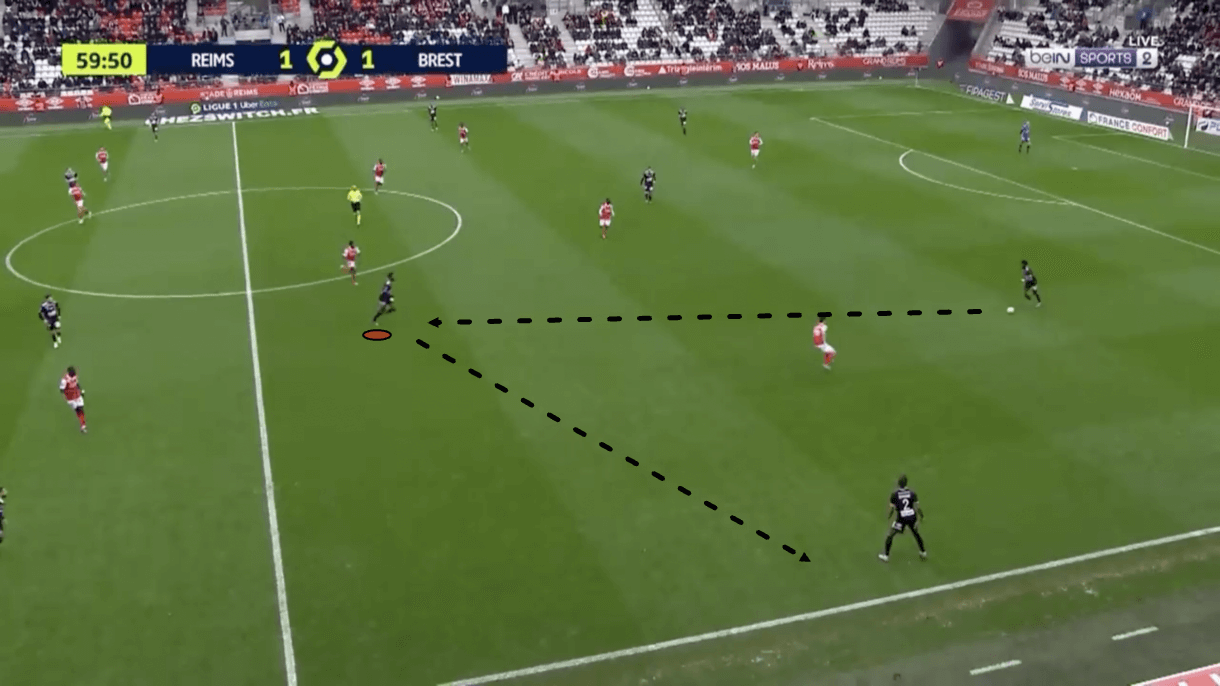
As an ‘8’, Agoumé showed himself to be effective at positioning himself to form triangles for his team to use as ball progression tools, which is highlighted in figure 6.
Here, the opposition’s right-winger is closing down the left centre-back — though doing a poor job of cutting the passing lanes at this moment.
However, he’s in the process of moving out to cover the passing lane between Brest’s left centre-back and left-back.
Agoumé is alert to this and drops into a great position to be effectively used as a wall for the left centre-back to bounce the ball off and into the path of the left-back, who could now receive ahead of him, behind the right-winger and in the direction he intends to progress it.
Again, this was very useful, effective movement and orientation from Agoumé to make himself available to facilitate his team’s ball progression.
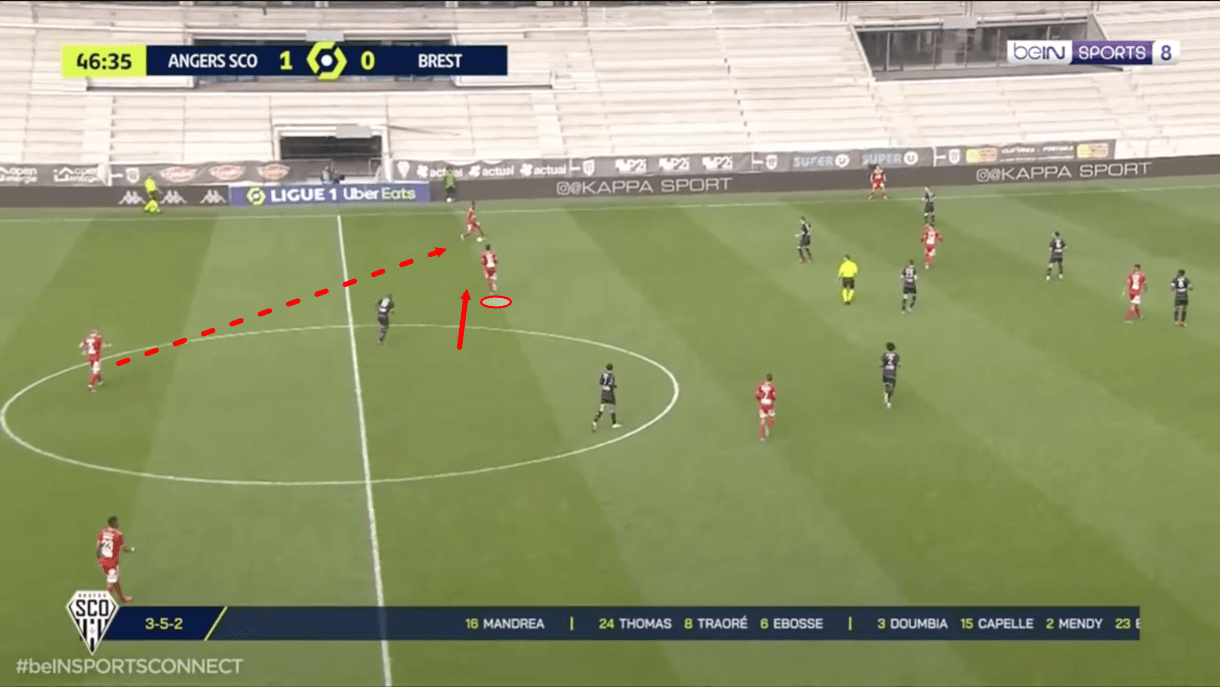
The Inter man isn’t perfect in terms of his movement, it must be said. Take figures 7-9, for instance.
Firstly, just before figure 7, we saw the left-back receive the ball from the left centre-back. Immediately, Agoumé started running out to provide the player with a short passing option, getting ahead of the opposition’s nearest defensive forward and leaving the pressure behind him.

However, moving on into figure 8, we can see that Agoumé ends up receiving in a precarious position on the left with no immediate forward passing options to take up and not many good angles available.
So, what was the purpose of this movement out to the left?
Yes, he got closer to the ball carrier and gave him a simple passing option but was it a good passing option? Was it the best possible position he could’ve taken up?
Could Agoumé have served his team better by remaining at a greater distance from the ball carrier and forcing the opposition’s nearest defensive forward to choose which player he would close down?
If he chose the ball carrier, Agoumé would have more space to receive in a more central position while if the opposition forward chose Agoumé, this would’ve created more time and space for the ball carrier and perhaps forced a different opposition player to step out and press, thus disrupting the defensive shape more and creating progressive passing options.
These are the considerations that the midfielder — especially the holding midfielder with their vital, central role in possession phases — must make.
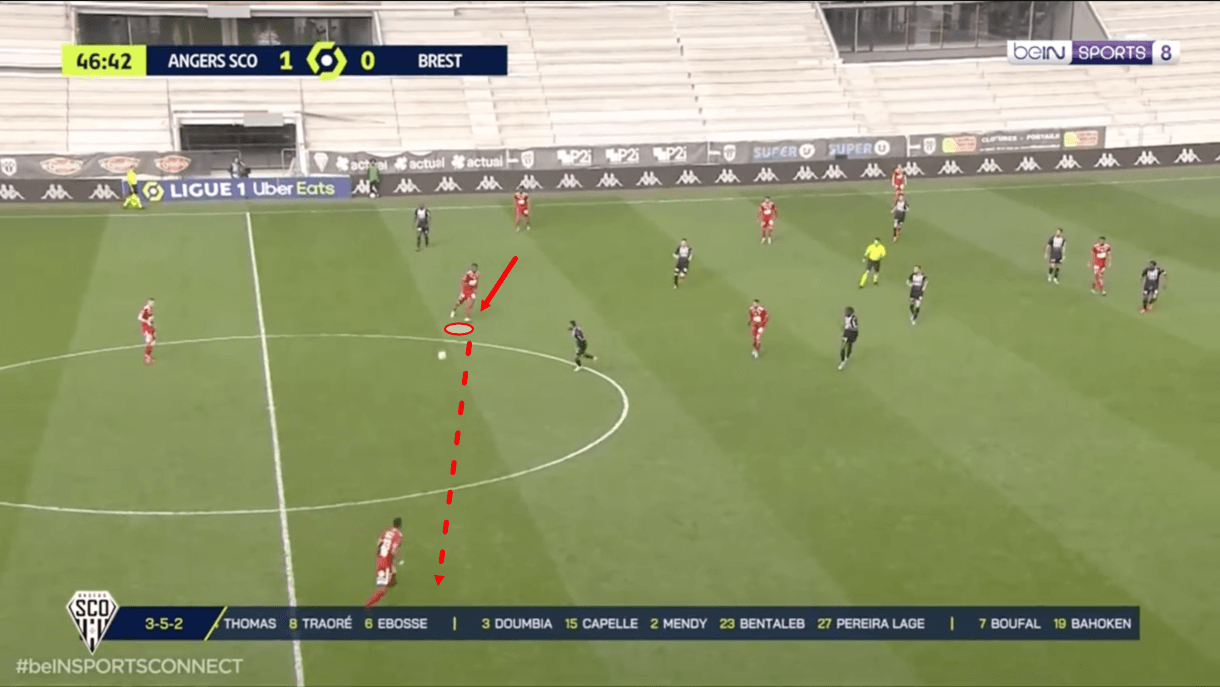
As the play moves on to figure 9, Agoumé ends up carrying the ball back into central midfield and, still with no forward passing options available, ends up taking the option of spreading the ball out to the right — not a bad option and probably a sensible one, but also one the opposition will be confident they can defend against.
Agoumé generally escapes pressure, makes good angles for his teammates to utilise and makes himself available for teammates to find very well.
However, he can get better at deciding when he should get closer to his teammate and when he should get further from them; he can improve his understanding of appropriate spacing on the pitch to better himself as a top-level midfielder.
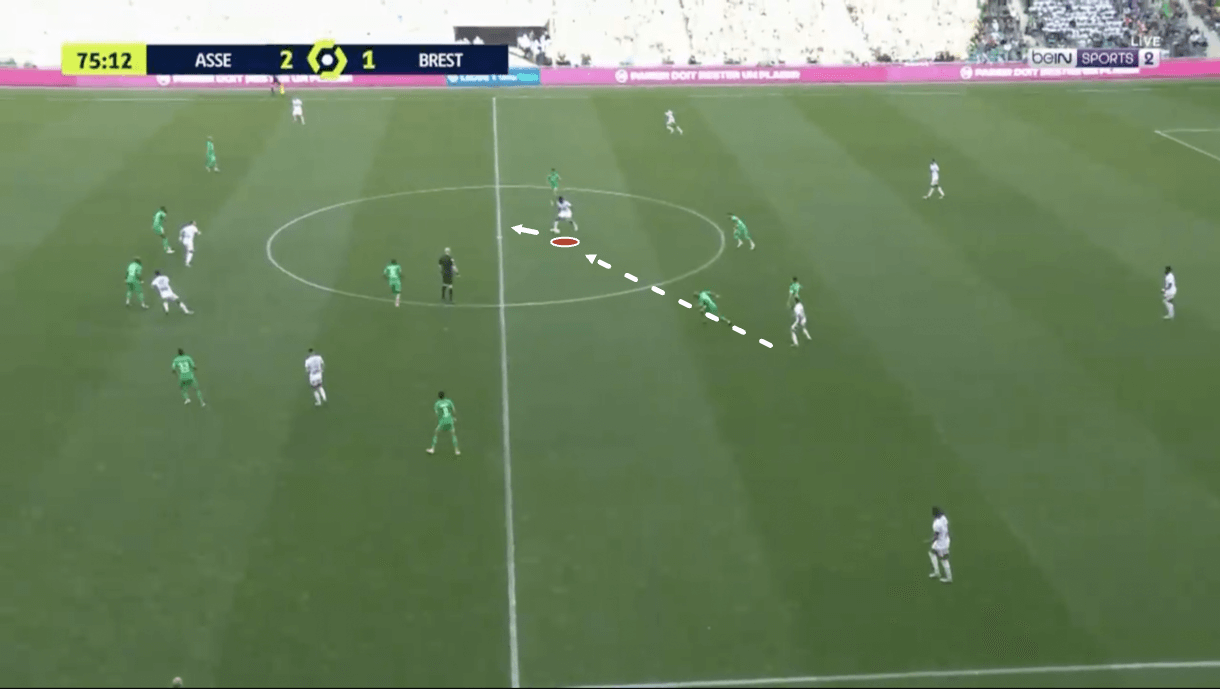
With that said, another positive in his game, as mentioned in the data section of our analysis, is his technical quality on the ball.
Agoumé can improve in this area mentally more than in any other way. But technically, he’s got solid ball progression ability.
Figure 10 shows the Inter midfielder receiving the ball well in central midfield, surrounded by opposition players but with none close enough to stop him from turning immediately as he receives the ball to face the business end of the pitch.
Agoumé is very good at receiving on the half-turn like this, and this can be a very useful skill for the player responsible for receiving from defence and progressing to attack — a cog that’s constantly pivoting around in the centre of the attack-producing machine.
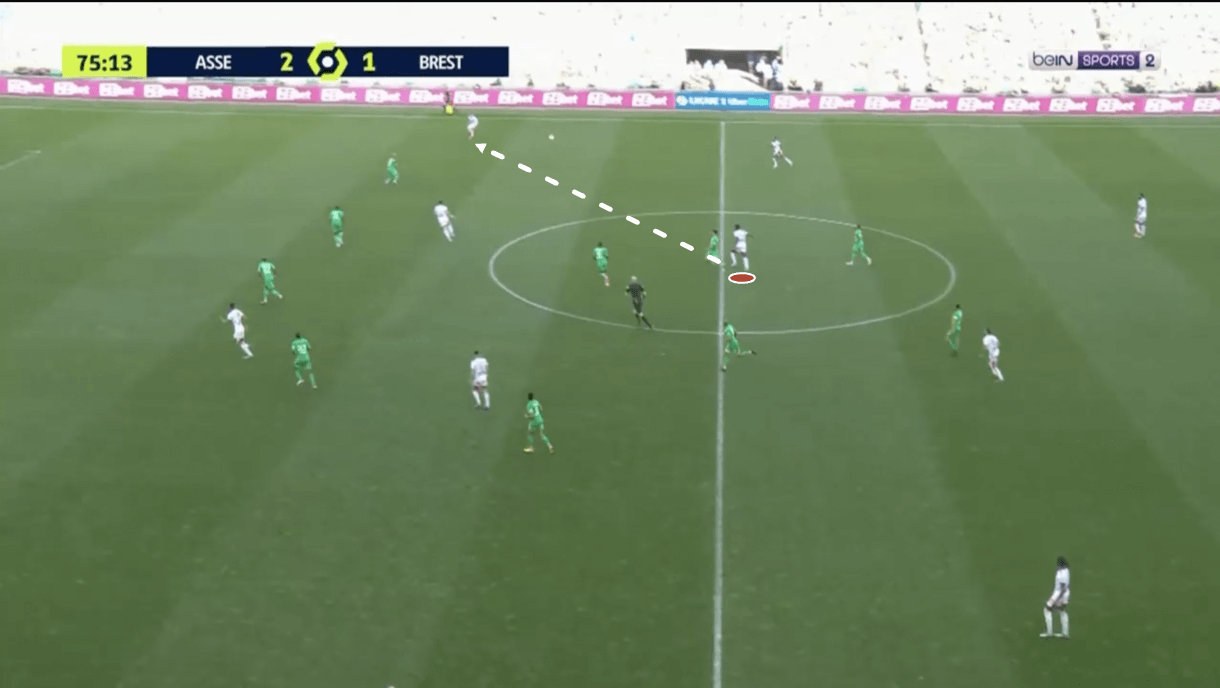
After having previously checked his shoulder for 1. Incoming opposition pressure and 2.
A better mental image of how the pitch looks ahead of him and where everyone is positioned, Agoumé turns here, gets his head up once more and spreads the ball out to Brest’s right-sided width-provider in figure 11.
This is an example of the midfielder’s impressive weaker left foot coming into play.
Despite being under plenty of pressure in a highly sensitive area of the pitch and having very little time to set himself and pick out his pass, Agoumé picked out his pass, connected with the ball and executed his idea brilliantly on his weaker left foot to set the right-sided width provider up in a 1v1 with the opposition’s left-back.
This is an excellent example of the not-often-enough-seen technical ability that Agoumé possesses as a ball progressor.
We look forward to seeing Agoumé grow as a player and utilise this technical ability to a greater extent as he develops in his career — the raw ability is there, it just needs to be honed in the right environment now.
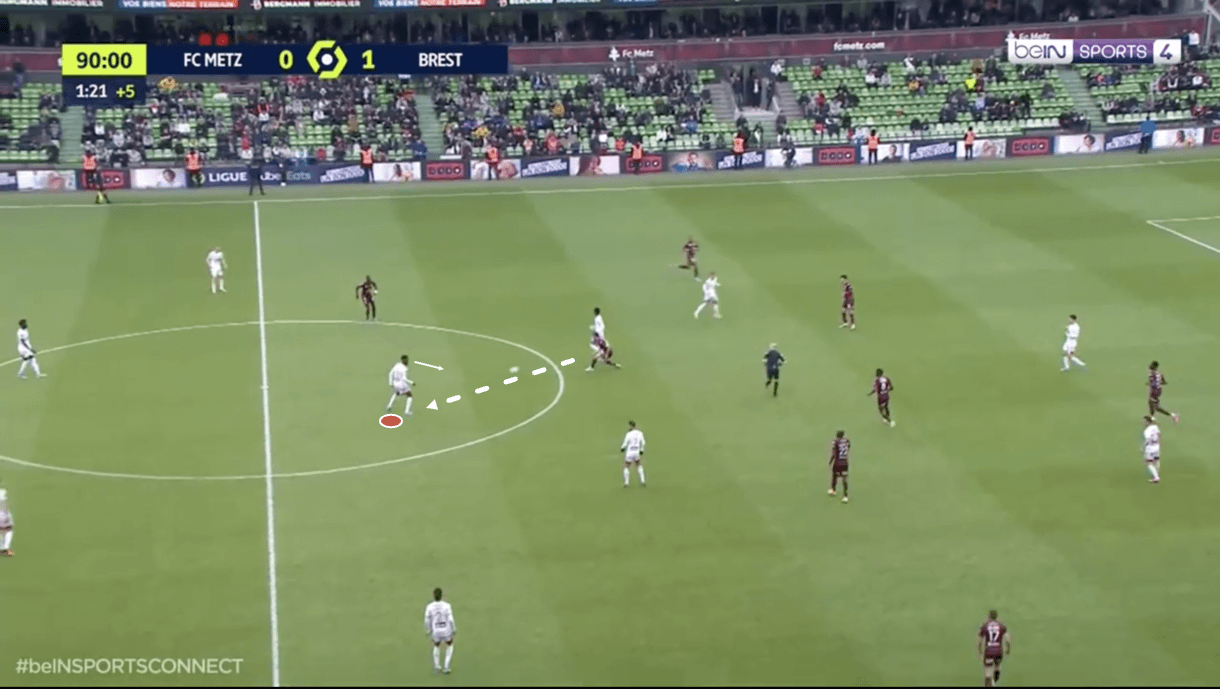
In terms of long passing, as we saw in figures 10-11 too, Agoumé is technically very good. Long passing is something the midfielder seems to really enjoy.
He’s super comfortable with spreading the ball around the pitch and has the technical quality to back this up.
This is an area of his game that Agoumé seems to be itching to exercise more and more.
Take figures 12-13, for example. In figure 12, we see the 20-year-old receiving the ball in central midfield from a more advanced midfielder.
He quickly scans towards the right of the pitch as the ball is in transit towards him — exhibiting intelligent scanning as he chose an appropriate moment at which the ball was not going to dramatically change state.
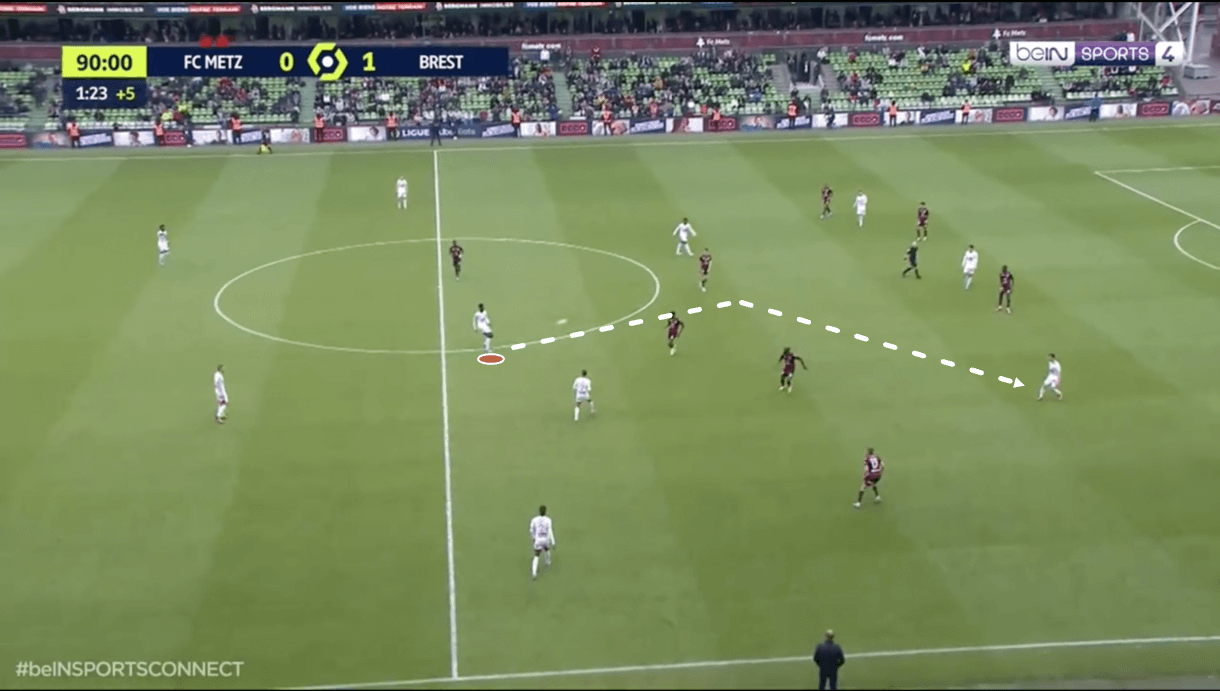
Agoumé receives the ball very well on his back foot, opening his body out towards the right before clipping the ball gently over the top to a free teammate on the right wing in space to receive, turn and attack the opposition’s underloaded backline.
This all looks very casual and simple from Agoumé but everything we mentioned here from a technical perspective is difficult to pull off, while mentally, he demonstrated lots of intelligence with this move.
Agoumé is undoubtedly a technically proficient and intelligent midfielder who can thrive in possession of the ball.
Out of possession
Our third and final section of analysis in this scout report looks at Agoumé’s performance out of possession, in what would commonly be described as ‘defensive’ phases of play.
We’ve already highlighted that Agoumé is a great option to have in midfield from a defensive perspective in our data section, but we can highlight some in-game examples of where he thrives similarly to the way in which we highlighted key areas of his in-possession game in section two.
Firstly, we know that interceptions are arguably Agoumé’s primary skill as a defensive midfielder from the data section, and the 20-year-old made the second-most interceptions of any Brest player last term, to add further fuel to that fire.
In terms of positioning and ability to read the game, Agoumé is very good, but where he really thrives in terms of his interception-making quality is in his relentlessness at constantly closing off passing lanes, ensuring he remains fully aware of the movement around him and the opposition ball carrier’s best possible passing options so that he can then reposition himself to cut off that passing lane and either slow the attack down by forcing the ball carrier to reconsider his options — thus creating a chance for his team to increase the pressure on that player — or intercept the pass if it is still played.
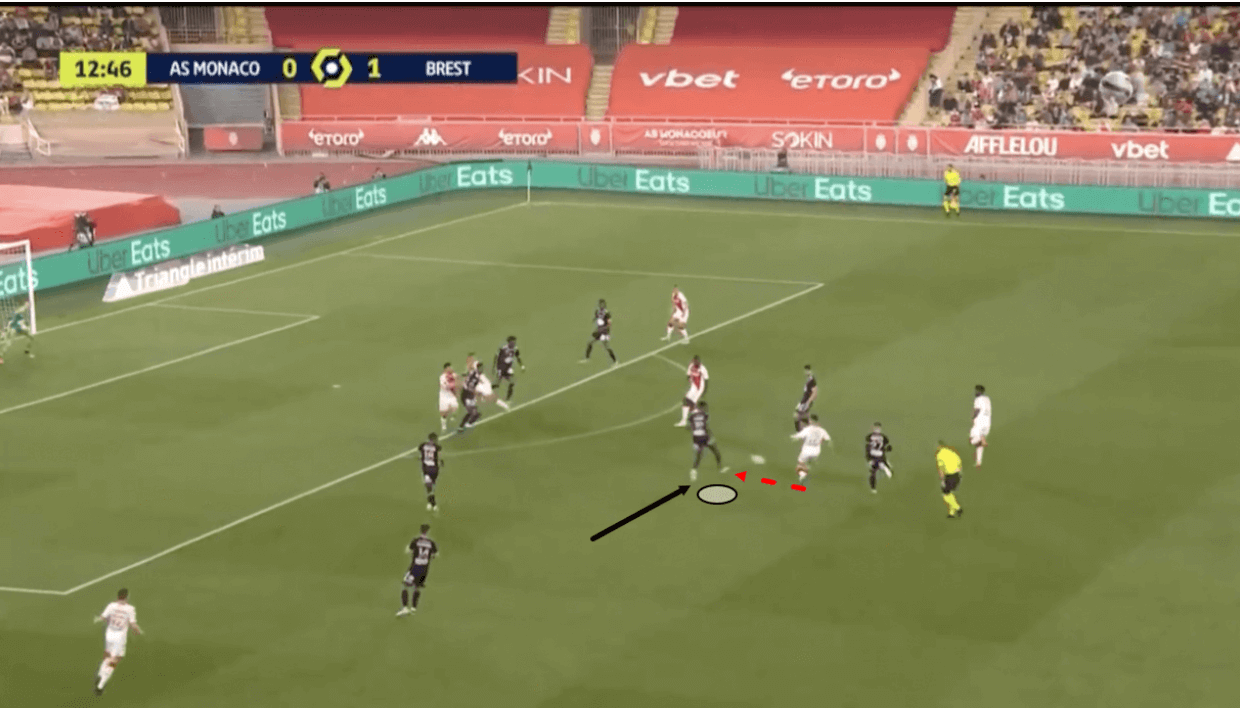
In figure 14, we see Agoumé darting in to intercept a ball intended to break Brest’s midfield line and play a man through in front of the backline — an interception that the 20-year-old successfully makes to end this promising opposition attack and kickstart a counterattack for his own side, which his impressive technical ability on the ball, even under pressure as we observed in the previous section, can help him to pull off successfully.
Just before this image, the midfielder had pressed the ball in a wider position towards his right wing but the opposition then moved it centrally.
However, Agoumé still managed to recover in time to regain possession for his side and end this attack, highlighting not just his spatial awareness and reading of the game, but also his impressive pace and a great attitude to not give up on regaining possession but keep going.
This is typical of Agoumé.
He’s not one to give up on a challenge and he’s constantly running about in defensive phases — not getting drawn to the ball constantly like a headless chicken, but rather constantly running about to close off passing lanes as we see here.
This is why we described him and his defensive style as ‘relentless’ at the beginning of this section, as well as a big part of why he is so effective at making interceptions.
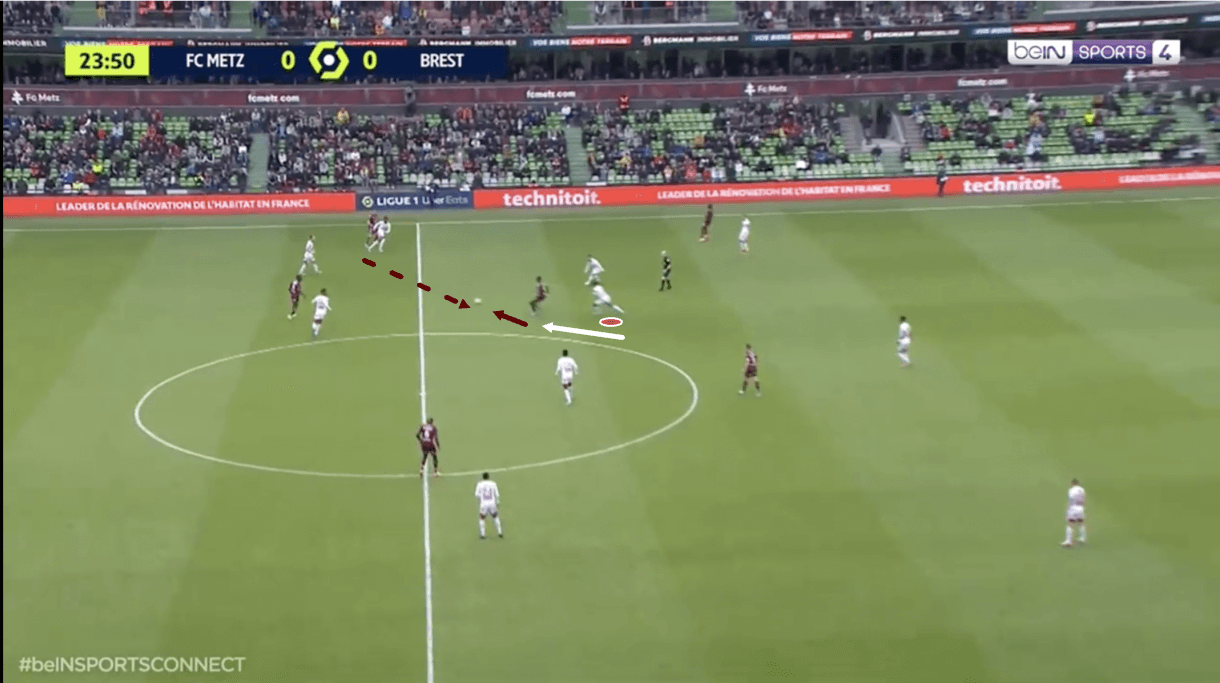
Agoumé is not at all afraid to close opposition players down as they receive the ball in his zone.
He can get drawn to the ball a little too much on occasion but, all in all, this is balanced out by effective pressure he applies to end attacks swiftly before they really get going, with figures 15-16 providing an example of this.
Firstly, figure 15 shows an opposition midfielder receiving the ball from his backline. However, he’s in Agoumé’s zone, and the 20-year-old is determined to exterminate any threats to his team’s goal that pop up in his defensive zone.
As a result, he sees the opportunity, with the pass receiver’s back to him, to close down the receiver and engage the player in a defensive duel.
This provides a perfect example of the kind of occasion when you’ll commonly see Agoumé applying slightly higher pressure.
He can safely press the receiver as he receives the pass while facing his own goal.
This is a good pressing trigger for the Inter man to use to dart forward, using his pace and intelligence together to close the player down quickly before he can turn to play the ball forward and exploit the space now opening up behind him, in front of Brest’s backline.
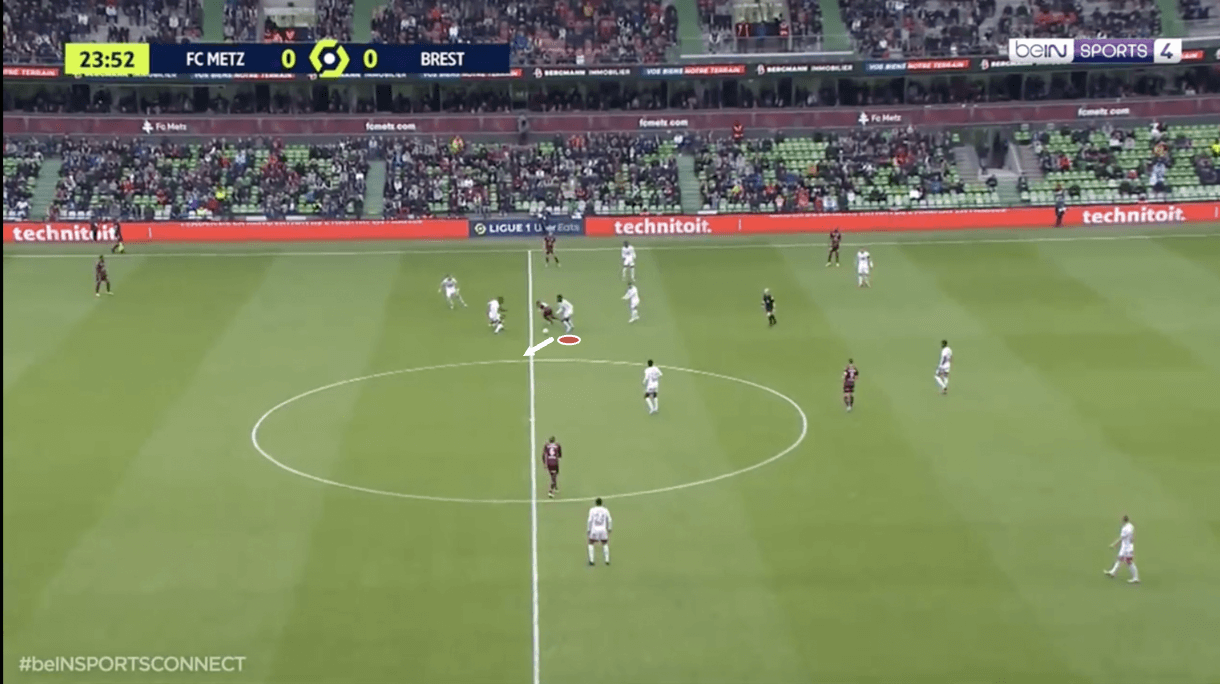
Moving on into figure 16, we can see that the midfielder successfully ended the attack on about the halfway line — so just as it was entering Brest’s half — regaining possession for his side and, again, setting up a counterattack opportunity.
This is the kind of situation where Agoumé’s excellent ball-winning quality and impressive ability on the ball meet at a crossroads and help the midfielder to pose a serious threat in transitions, which we saw plenty of at Brest in the last term.
Agoumé was quite good at entering duels when the odds were in his favour for reasons like the ones we discussed while analysing this passage of play.
This intelligent decision-making with regard to when he should and should not enter defensive duels was key for creating the highly impressive defensive duel success rate we saw in the first section of this analysis.
So, a combination of physicality, intelligent movement and game-reading ability, along with great technical defensive qualities all combined to make Agoumé a menace for opposition attackers in Ligue 1 last season.
Conclusion
To conclude this tactical analysis and scout report, we must reiterate that, while we are obviously quite high on Agoumé and his potential, it remains just that — potential — for the time being. He is not a guarantee and remains quite raw.
However, provided he gets to continue his development in the right environment that nourishes the player mentally, physically and technically, allowing him to shine in the areas we’ve highlighted, and the player continues to keep his head down and not get carried away with the hype and stick to playing his game week-in-week-out, Agoumé is one we can be excited about.





Comments